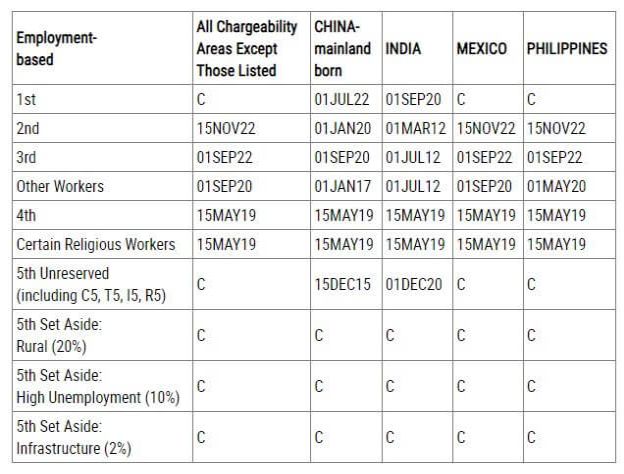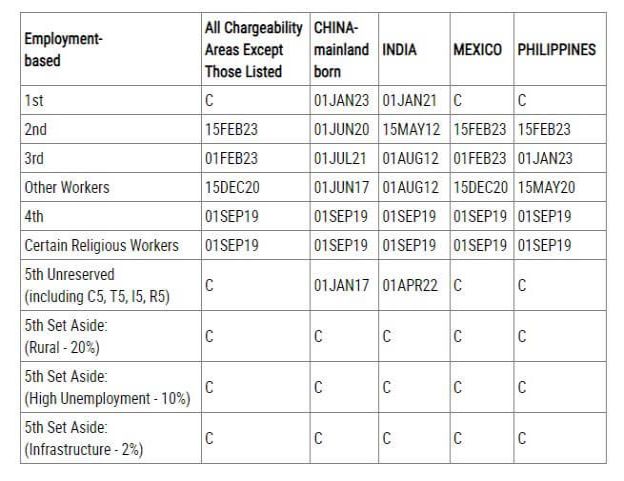U.S. Citizenship and Immigration Services (USCIS) and the U.S. Department of State have not indicated significant advancement in the priority dates for employer-based immigrant petitions, continuing the fiscal year (FY) 2024 trend of long wait times for immigrant visas.
Quick Hits
- USCIS and the State Department reported minimal movement in the EB-2 and EB-3 categories for Mexico, the Philippines, and all other chargeability areas except India and China.
- USCIS authorized use of the Dates for Filing chart.
- Continued limitations on immigrant visas particularly impact chargeability areas of India and China where employers and individuals had hoped to take advantage of shorter wait times in the EB-1 category.
The February 2024 Visa Bulletin
USCIS will continue to use the Dates for Filing chart in the February 2024 Visa Bulletin in determining eligibility for I-485, Application to Register Permanent Residence or Adjust Status, filings. The Dates for Filing chart reflects priority dates anticipated to become current during the fiscal year, whereas the Final Action Dates chart reflects priority dates considered current and available for the specific month. This means that while an applicant may file the I-485 based on the Dates for Filing chart, the application will not be adjudicated at least until the applicant's priority date becomes current on the Final Action Dates chart.
In summary, there is no advancement in final action dates for China and India in all employment-based categories except that the Other Workers category for India has advanced by one month. For all other chargeabilities, Mexico, and the Philippines, the EB-1 category remains current, the EB-2 category advances by fifteen days, the EB-3 category advances by one month, and the EB-4 Certain Religious Workers category remain the same.
The Final Action Dates chart is shown below.

Source: U.S. Department of State, February 2024 Visa Bulletin
USCIS has confirmed its continued use of the Dates for Filing chart for adjustment of status filing purposes. However, the dates for filing remain the same as in the January 2024 Visa Bulletin in all categories for all countries.
The Dates for Filing chart for employment-based categories follows below.

Source: U.S. Department of State, February 2024 Visa Bulletin
Impacts of Immigrant Visa Backlogs, Slow Movement, and Retrogression: EB-1 Considerations
In the January 2024 Visa Bulletin, we saw some forward movement in certain employment-based categories, particularly in the EB-1 category. This movement aligned with the hope that all EB categories, including the EB-1 category, would advance significantly or at least steadily. USCIS and the State Department had also indicated holding this hope in the August 2023 Visa Bulletin. However, the Visa Bulletins for October 2023, November 2023, December 2023, and January 2024 showed slow movement, with the Visa Bulletin for February 2024 indicating little to no movement at all.
The lack of advancement in priority dates particularly impacts those chargeable to India and China. While those chargeable to India and China have historically experienced long green card wait times in the common categories of EB-2 and EB-3, many employers and individuals choose to pursue the EB-1 category in hopes to secure the green card in a much shorter time. The benefits to an employer if a sponsored employee receives a green card earlier is that there is a reduction in immigration costs and a reduction in time that an employer would be beholden to immigration regulations. The employer can also rest assured that their talent can be retained beyond the limits of a nonimmigrant visa status.
However, despite the retrogression of the EB-1 categories for China and India, there still stands a benefit that visa availability wait times for the EB-1 category remains much faster than any other category. Employers considering pursuing the EB-1 process for their employees may want to note that the EB-1 holds an extremely high standard. The EB-1 is generally reserved for highly talented individuals who have risen to the top of their field or individuals who will work in a managerial capacity in addition to meeting other narrow criteria.
The content of this article is intended to provide a general guide to the subject matter. Specialist advice should be sought about your specific circumstances.

